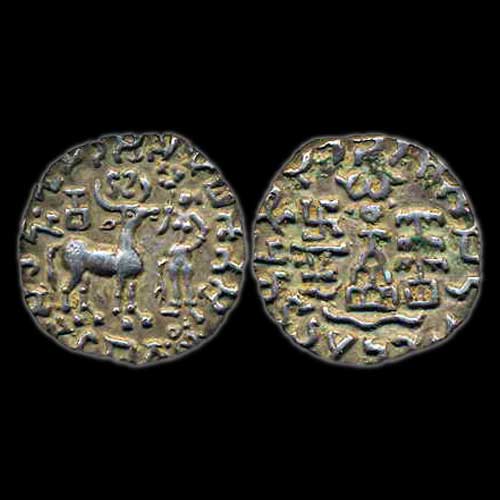Silver Drachma of Amoghabhuti
2017-10-25 Wed
In 2nd century BCE, there was a native kingdom in the northern region of India called Kuninda stretching along with the foothills of Himalaya. Ptolemy, the Greek historian linked the origin of the Kuninda to the country where rivers like Ganges, Yamuna and Beas (Vyas) originated. The very well known ruler of this kingdom was Amogh also known as Amoghabhuti.Amoghabhuti is known for his beautiful silver and copper coinage. His silver coinage follows the silver standards of Indo-Greek coins. This similarity may suggest the evidence of commercial exchange with its neighbouring kingdoms. Before Amogh’s coinage, the currency circulated in this land was the drachms and tetradrachms of the Indo-Greek rulers.
The above-shown coin is a silver drachm of Amoghbhuti. The obverse of this coin depicts Lakshmi and a deer in the centre surrounded by Brahmi legend ‘Rajno Kunidasa Amoghabhutisa Maharajasa’. The reverse of this coin depicts indradhvaja, swastika, nandipada, a tree in the railing, six arched hill and river below; Kharoshthi legend around.
The design of this coinage was purely native. One of the Edicts of Ashokan pillar of Kalsi in Garwal region indicated the spread of Buddhism in this region which also been seen on Kunindas coins. By the advent of the 3rd century CE, this small Kingdom disappeared from pages of history.
To know more about Kunindas kingdom click here.
Learn more about Kunindas coinage.
Interesting facts
The coins of Kuninda are often found with the coins of Indo-Greek along with Yadheyas and Audumbaras.
Latest News
-
Ghiyath Shah as Sultan
2025-10-17 FriAfter ascending the throne of the Malwa Sultanate, Ghiyath Shah issued circular coins early in his r...
-
Malwa Sultan Ghiyath Shah Square Gold Tanka
2025-10-16 ThuMalwa Sultan Ghiyath Shah issued square gold tankas in three weight standards: Double Tanka (21.9g),...
-
Malwa Sultan Ghiyath Shah's Billon Tanka as Heir Apparent
2025-10-14 TueIn Billon, Ghiyath Shah issued coins under two weight standards. Billon Tanka of 96 rati (10.7-11g),...
-
Antiochos I Soter Silver Tetradrachm, weighing 16.87 grams, sold for INR 22,000.
2025-10-07 TueAntiochos I, the Greek king of the Seleucid Empire, was of mixed heritage, being half-Iranian and ha...
-
Ghiyath Shah as Heir Apparent
2025-09-25 ThuGhiyath Shah was the ruler of the Malwa Sultanate, reigning from 1456 to 1500. From 1456 to 1469, he...

